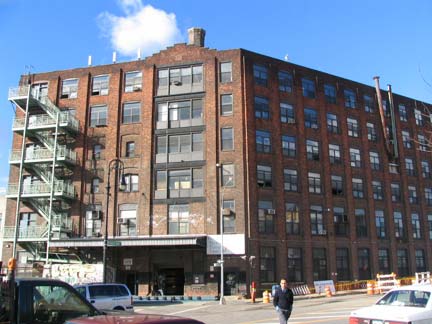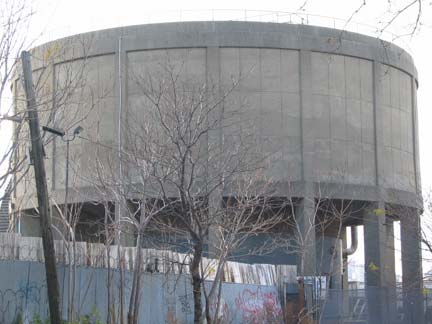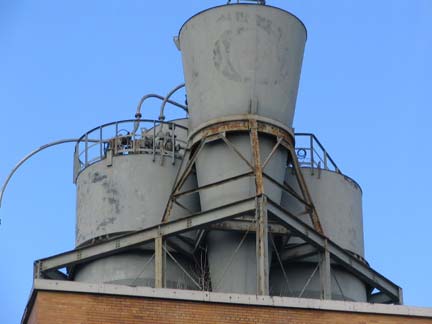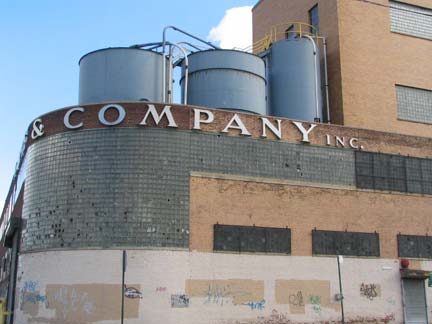Greenpoint Savings Bank, Manhattan Avenue and Calyer St.
KNOWN as the “garden spot of Brooklyn”, an eponym bestowed by theBrooklyn Eagle many years ago, Greenpoint is Brooklyn’s northernmost neighborhood, separated from Long Island City by Newtown Creek. It is the place where the country’s first ironsided warship, the Monitor, was built, the land of Mae West’s birth, and the place where your webmaster once rented an apartment for two weeks.
Let’s take a look at this Polish-Hispanic enclave from north to south.

The big building at Manhattan Avenue and Commercial Street is the former Chelsea Fiber Mills Building, now the Greenpoint Manufacturing and Design Center. GMDC rehabilitates vacant maunfacturing buildings for use by small companies.

Tank on Commercial Street west of Franklin Street, that just might have been the original model for the Felt Forum at Madison Square Garden, perhaps?

Don’t know what Harte & Company actually does but I enjoy its national headquarters at Franklin and Commercial, especially that wraparound window, made up with multiple glass panels.

The other side of Franklin and Commercial Streets features a somewhat desolate playground, oddly placed in this über-indüstrial area. Commercial Street itself faces a terrific view of mid-Manhattan, which, as usual in Brooklyn waterfront areas, is off limits to most, behind barbed wire.
The King of All Buildings can be seen spectacularly from Greenpoint, as well as from southern Queens communities just to the north. Directly in front of the ESB is 3 Park Avenue, a building turned at a diagonal to the street grid, completed in 1976. I’ve visited offices on the 38th floor which provide spectacular all-around views.
This swing bridge, constructed in the 1800s, connected Manhattan Avenue in Greenpoint with Vernon Avenue in Long Island City over Newtown Creek. It was replaced in 1954 by the massive Pulaski Bridge a block to the east.
Street art at the northern end of Manhattan Avenue oppoite the Manufacturing and Design Center.
Two buildings, Franklin and Eagle Streets. Franklin Street was the original road from Greenpoint to Long Island City, opening in 1839 as a toll road. It was built by industrialist, shipbuilder, and real estate speculator Neziah Bliss.
Eberhard Faber, the scion of a Bavarian pencil producing family, arrived in the USA from Germany in 1848, and after his first USA pencil factory on Manhattan’s east side burned down in 1861, he relocated to Greenpoint in 1872. His son Eberhard II (he had changed his name from John) took over the company, which remained in Greenpoint until 1956 when it decamped to Wilkes-Barre, PA. Faber is recalled by a large sign facing the East River painted on its original 1872 building at 37 Greenpoint Avenue at West Street, and by the huge yellow terra cotta pencils on its old Art Deco building next door at Franklin. The pencil factory itself, on Franklin Street near Java, is recognizable by a distinctive yellow star-in-diamond symbol.
Pierce Steam Laundry, off West Street; “Syrup of Figs” sign on Greenpoint near Franklin. “Syrup of figs” was not a dessert as I had originally imagined but rather, a laxative mixture, rather similar to Fletcher’s Castoria. As a matter of fact, syrup of figs is still used as a laxative.
Brooklyn has a Manhattan Avenue, but can you imagine Manhattan with a Brooklyn Avenue? I didn’t think so. The northern end of Manhattan Avenue, Greenpoint’s spine, has many Forgotten relics. I found the hotel with mattresses piled in the windows intriguing, as well as the building which, except for the four small windows, has not one opening that is the same.
Don’t know the history of J. Joseph and sons, but they have quite the little empire on Manhattan Ave., with a full block worth of shops, and an ancient neon sign.
Might the Norwood, at 960 Manhattan, have been a hotel originally? The abandoned JK Restaurant Supplies, next door, is an example of the dual nature of Greenpoint, with some pockets stubbornly resisting a comeback. Everything is broken, as Dylan says.
I arrived in Greenpoint in 1982, on the news that it was on the verge of a comeback. It took about 20 years for the comeback, if you can call it that, to happen, spurred from nearby Williamsburg, where trendies from the East Village had arrived and spilled northward, to a degree. The reality was that Greenpoint was never necessarily in need of a comeback. It’s been a remarkably stable area of Polish and Hispanic emigres for most of the 20th Century and on into the 21st.
My apartment, however, on Green Street, was in need of a comeback. There was a bathtub in the kitchen and a single electrical outlet to suffice for two and a half rooms. I got out of the lease and obtained an apartment in Bay Ridge, where I remained for the next 8 years before being ousted because the super needed the room “for his daughter.” What their real purpose was, was to renovate the place and invite me back in at a much higher rent, which I refused. But back to Manhattan Avenue.
I’m fascinated by stopped clocks on the street; most exterior clocks are no longer maintained.
I believe Halpern-Perlow was a men’s clothing store.
When you’ve got a good sign, you don’t need to ever replace it. The old school phone number, probably EVergreen, is still there too.
I’m fascinated by the detail on the old Meserole Theater, now an Eckerd durgstore. It was built in the 1920s where the old Meserole family farm had stood. Might that be why there are cattle skulls as part of the decor?
Some of the interior detail of the Meserole has been preserved on the drugstore ceiling. Photo: Chris Sattler
Greenpoint Savings Bank, on Manhattan and Calyer. It was built in 1908 by Helmle and Huberty. The bank itself was established in 1869. RIGHT: ad for R&G Corsets above another partially obscured ancient ad.
BELOW: Dunne’s Polemost Liquors, shot from a bus window. This name strikes me as incredibly corny, given that this is a Polish neighborhood, but that’s Greenpoint.
If Manhattan Avenue forms Greenpoint’s Y axis, Greenpoint Avenue makes the X. It was laid out in 1852 as a means of bringing Manhattanites to the new Calvary Cemetery in Maspeth. It has been previously called L, and then Lincoln, Street. If you follow it eastward, it reaches Sunnyside, Queens, changes its name to Roosevelt Avenue, and plunges into Woodside, Corona and ultimately, Flushing.
Walsh’s Shoe Factory and the gorgeous 1895 Mechanics and Traders Bank Building at Franklin Street, now the offices of the Polish newspaper Novy Dziennik (“New Day”) are near the avenue’s western end.
Photo: bridgeandtunnelclub
f you have a wedding or a Confirmation to get to at the Polonnaise catering hall, you have to make your way down Greenpoint Avenue past the old stables and the poultry slaughtering joint.
It looks like Frank Gehry dropped in on this Greenpoint Ave doorway east of Manhattan Avenue. Old-school Greenpoint reasserts itself a few doors down.
Terra cotta griffin detail, building on Greenpoint Avenue near McGuinness Boulevard
The rusting industrial area on West Street, the western end of Greenpoint, has been the location for dozens of motion picture scenes where a desolated area is in the script. In Romeo Is Bleeding, Lena Olin attempts to garrote Gary Oldman, who crashes his car here to avoid getting killed. Lena squeezes out of the smashed windshield and hobbles down West Street in her underwear, which she appears in for most of the movie. Oakum is manufactured for plumbers and used for packing around steel pipe fittings or caulking lead joints.
A water tower on Noble near West Street is inscribed with the Polish flag on one side and “Save the Palestine” on the other.
Parts of West Street are lined with what I have never seen in other parts of NYC: sidewalks made up of cut wooden blocks.
Landmarked Milton St., a block south of Greenpoint Avenue, is among the area’s finest residential areas. The street is marked by two tall spires, belonging to St. John’s Lutheran Church (1892), a remnant of Greenpoint’s now-departed German population, and the red brick-white limestone 240-foot tall St. Anthony of Padua, a Catholic church built in 1875.
Walking on Guernsey north of Calyer (noting the distinctive 2-story brick building on the corner) produces one of Greenpoint’s most pleasant surprises: a bend in the road turns into Oak Street. On the left is a house where a friend lived in the 1980s; he had the top floor bay window, from which we could see the picturesque scene. A back window afforded a view of the King of All Buildings. Partially shown on the right is a building once known as Greenpoint Home for the Aged, set considerably back from the street. It was built in 1887.
Greenpoint is the birthplace of Brooklyn’s longest street, Bedford Avenue, which begins at Manhattan Avenue a little north of Nassau and runs southwest, southeast and south through Williamsburg, Bedford-Stuyvesant, Crown Heights, Flatbush, Midwood, and Sheepshead Bay to Emmons Avenue. In Williamsburg, Bedford Avenue was called 4th Street until about 1890.
Monsignor McGolrick Park, bounded by Russell and Monitor Streets and Nassau and Driggs Avenues, was originally named Winthrop Park and renamed in 1941 for a beloved pastor of nearby St. Cecilia’s Church, Msgr. Edward McGolrick. The park contains a triumphant crescent-shaped shelter pavilion designed in 1910 by famed architectural firm Helmle and Huberty.
The John Ericsson (Monitor and Merrimac) Monument by sculptor Antonio de Filippo was dedicated in 1938. Engineer Ericsson built the Monitor, the USA’s first ironclad warship, at Greenpoint’s Continental Iron Works in 1861, and engaged the Confederate States’Merrimac at Hampton Roads in 1862. Less than a decade after the battle, William Street was renamed for the famed vessel.
PS 110, 124 Monitor Street, built 1895
St. Stanislaus Kostka, Driggs Avenue & Humboldt Street. Former Polish president Lech Walesa and Pope John Paul II have each visited.
St. Cecilia, just below the southern Greenpoint border at Herbert Street and North Henry Street, is recognizable for miles by its illuminated green dome.
More Greenpoint:
Greenpoint’s Enchanted Villages
McCarren Park Pool
Bridge and Tunnel Club in Greenpoint
Sources: Big Onion Guide to Brooklyn, Seth Kamil and Eric Wakin, NYU Press 2005
BUY this book at Amazon.COM
Your webmaster shot these images in August and December 2004 and wrote the page on April 30-May 1st, 2005.
